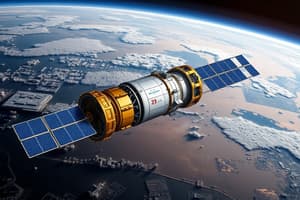Podcast
Questions and Answers
What was unique about Chandrayaan-1?
What was unique about Chandrayaan-1?
- It discovered traces of water on the moon (correct)
- It was the first satellite navigation system by India
- It was India's first lunar mission
- It was launched on 28 April 2016
Which country became the first to successfully put a Mars Orbiter into Mars' Orbit in its first attempt?
Which country became the first to successfully put a Mars Orbiter into Mars' Orbit in its first attempt?
- Russia
- China
- India (correct)
- USA
What is the purpose of the Indian Regional Navigation Satellite System (IRNSS)?
What is the purpose of the Indian Regional Navigation Satellite System (IRNSS)?
- To understand Mars' evolution
- To establish satellite navigation system (correct)
- To study moon minerals
- To provide educational services
Which satellite was dedicated exclusively for educational services?
Which satellite was dedicated exclusively for educational services?
When was Chandrayaan-2, India's second unmanned Lunar Mission, successfully launched?
When was Chandrayaan-2, India's second unmanned Lunar Mission, successfully launched?
What type of education system involves computer as a medium of instruction?
What type of education system involves computer as a medium of instruction?
When was Aryabhata, India's first satellite, launched?
When was Aryabhata, India's first satellite, launched?
What is the primary function of SCATSAT-1, India's latest weather forecasting satellite?
What is the primary function of SCATSAT-1, India's latest weather forecasting satellite?
How many operational communication satellites are there in the INSAT system in the Asia-Pacific region?
How many operational communication satellites are there in the INSAT system in the Asia-Pacific region?
Which launch vehicle was used to induct GSAT-24 into the INSAT System?
Which launch vehicle was used to induct GSAT-24 into the INSAT System?
What are some advantages of satellite communication mentioned in the text?
What are some advantages of satellite communication mentioned in the text?
What benefits does SARAL, India's remote sensing satellite, provide?
What benefits does SARAL, India's remote sensing satellite, provide?
Flashcards are hidden until you start studying
Study Notes
Indian Space Research Organisation (ISRO) Achievements
- India is among the five nations in the world that have established their own satellite navigation system, with the launch of Indian Regional Navigation Satellite System (IRNSS) IRNSS-1G on 28 April 2016.
- IRNSS-1G allows users to find their location with GPS.
Chandrayaan Series
- ISRO launched Chandrayaan-1, India's unmanned mission to the Moon, on 22 October 2008, which became the first lunar mission to discover water on the Moon.
- Chandrayaan-2, India's second unmanned Lunar Mission, was successfully launched on 22 July 2019 to further understand the origin and evolution of the Moon.
Mangalyaan
- ISRO launched India's first Mars Orbiter Mission (MOM), called the Mangalyaan, on 5 November 2013.
- On 24 September 2014, India became the first country to put a Mars Orbiter into Mars' orbit in its first attempt.
E-Learning and EDUSAT
- Electronic Learning (E-Learning) is an education system where the medium of instruction is through a computer.
- EDUSAT is a satellite designed by ISRO, dedicated exclusively for educational services.
Aryabhata and INSAT/GSAT System
- Aryabhata was India's first satellite, launched on 19 April 1975 from Kapustin Yar, Soviet Union, which gave ISRO experience in building and operating a satellite in space.
- The Indian National Satellite (INSAT) system is one of the largest domestic communication satellite systems in the Asia-Pacific region, with nine operational communication satellites in the Earth's geo-stationary orbit.
- GSAT-24 was inducted into the INSAT system on 23 June 2022 from Kourou, French Guiana, by Ariane-5 VA-231 Launch Vehicle.
Communication Satellites
- Advantages of communication satellites include:
- Establishing mobile communication easily
- Being economical in remote areas where no landlines exist
- Being more economical compared to terrestrial communication, particularly for long-distance calls
SCATSAT-1 and SARAL
- SCATSAT-1, India's latest weather forecasting satellite, was launched on 26 September 2016, providing weather forecasting and cyclone predictions.
- SARAL, India's remote sensing satellite, was launched on 25 February 2013, with benefits including drought monitoring, flood damage assessment, and locating underground resources.
Studying That Suits You
Use AI to generate personalized quizzes and flashcards to suit your learning preferences.




